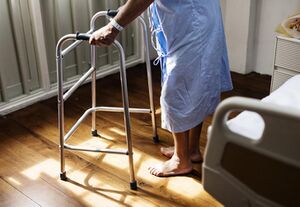Yubi Wakka Finger Ring Test: Difference between revisions
Candace Goh (talk | contribs) mNo edit summary |
No edit summary |
||
| Line 9: | Line 9: | ||
Conduct self-test in a seated position, no instrument required. | Conduct self-test in a seated position, no instrument required. | ||
# Make a ring with the index fingers and thumbs of both hands | |||
# Gently circle the thickest part of the non-dominant calf of the leg which is bent at a 90° angle | |||
# Check whether or not the non-dominant calf circumference is“bigger,”“just fits”or“smaller” as compared with the finger-ring circumference. | |||
== Evidence == | == Evidence == | ||
The "Yubi-wakka" assessment represents a highly useful approach for pinpointing older individuals who are vulnerable to sarcopenia, disability, and the risk of mortality. | The "Yubi-wakka" assessment represents a highly useful approach for pinpointing older individuals who are vulnerable to sarcopenia, disability, and the risk of mortality. | ||
Given the generally robust health and longevity of the Japanese population, addressing sarcopenia becomes particularly crucial, particularly for individuals aged over 75 years. The existence of metabolic syndrome, as identified through the Yubi-wakka test, might constitute a potential risk factor for sarcopenia and subsequent frailty. This warrants heightened vigilance, particularly in the case of women<ref>Fujii H, Kodani E, Kaneko T, Nakamura H, Sasabe H, Tamura Y. [https://www.ncbi.nlm.nih.gov/pmc/articles/PMC9806034/ Sarcopenia and coexistent risk factors detected using the ‘Yubi-wakka’(finger-ring) test in adults aged over 65 years in the public annual health check-up in Tama City, Tokyo: a cross-sectional study.] BMJ open. 2022 Dec 1;12(12):e061613.</ref>. | * This test has the potential to enhance proactive measures in preventing sarcopenia by acting as an early warning for older adults to guard against developing this condition.<ref name=":0" /><ref>Fujii H, Kodani E, Kaneko T, Nakamura H, Sasabe H, Tamura Y. [https://www.ncbi.nlm.nih.gov/pmc/articles/PMC6731048/ “Yubi-wakka”(finger-ring) test: a tool to detect prefrailty in elderly populations, a pilot study.] Journal of Clinical Medicine Research. 2019 Sep;11(9):623.</ref> | ||
* Given the generally robust health and longevity of the Japanese population, addressing sarcopenia becomes particularly crucial, particularly for individuals aged over 75 years. | |||
* The existence of [[Metabolic Syndrome|metabolic syndrome]], as identified through the Yubi-wakka test, might constitute a potential risk factor for sarcopenia and subsequent [[Introduction to Frailty|frailty]]. This warrants heightened vigilance, particularly in the case of women<ref>Fujii H, Kodani E, Kaneko T, Nakamura H, Sasabe H, Tamura Y. [https://www.ncbi.nlm.nih.gov/pmc/articles/PMC9806034/ Sarcopenia and coexistent risk factors detected using the ‘Yubi-wakka’(finger-ring) test in adults aged over 65 years in the public annual health check-up in Tama City, Tokyo: a cross-sectional study.] BMJ open. 2022 Dec 1;12(12):e061613.</ref>. | |||
== Resources == | == Resources == | ||
Revision as of 07:51, 18 September 2023
Purpose[edit | edit source]
The“Yubi-wakka" (finger-ring) test is a simple self-screening tool developed by the Japanese to check for sarcopenia among community-dwelling older adults.[1]
Technique[edit | edit source]
Conduct self-test in a seated position, no instrument required.
- Make a ring with the index fingers and thumbs of both hands
- Gently circle the thickest part of the non-dominant calf of the leg which is bent at a 90° angle
- Check whether or not the non-dominant calf circumference is“bigger,”“just fits”or“smaller” as compared with the finger-ring circumference.
Evidence[edit | edit source]
The "Yubi-wakka" assessment represents a highly useful approach for pinpointing older individuals who are vulnerable to sarcopenia, disability, and the risk of mortality.
- This test has the potential to enhance proactive measures in preventing sarcopenia by acting as an early warning for older adults to guard against developing this condition.[1][2]
- Given the generally robust health and longevity of the Japanese population, addressing sarcopenia becomes particularly crucial, particularly for individuals aged over 75 years.
- The existence of metabolic syndrome, as identified through the Yubi-wakka test, might constitute a potential risk factor for sarcopenia and subsequent frailty. This warrants heightened vigilance, particularly in the case of women[3].
Resources[edit | edit source]
- Factors associated with sarcopenia screened by finger-circle test among middle-aged and older adults: a population-based multisite cross-sectional survey in Japan
- Comparison of four screening methods for sarcopenia among community-dwelling older adults: A diagnostic accuracy study.
References[edit | edit source]
- ↑ 1.0 1.1 Tanaka T, Takahashi K, Akishita M, Tsuji T, Iijima K. “Yubi‐wakka”(finger‐ring) test: A practical self‐screening method for sarcopenia, and a predictor of disability and mortality among Japanese community‐dwelling older adults. Geriatrics & gerontology international. 2018 Feb;18(2):224-32.
- ↑ Fujii H, Kodani E, Kaneko T, Nakamura H, Sasabe H, Tamura Y. “Yubi-wakka”(finger-ring) test: a tool to detect prefrailty in elderly populations, a pilot study. Journal of Clinical Medicine Research. 2019 Sep;11(9):623.
- ↑ Fujii H, Kodani E, Kaneko T, Nakamura H, Sasabe H, Tamura Y. Sarcopenia and coexistent risk factors detected using the ‘Yubi-wakka’(finger-ring) test in adults aged over 65 years in the public annual health check-up in Tama City, Tokyo: a cross-sectional study. BMJ open. 2022 Dec 1;12(12):e061613.







